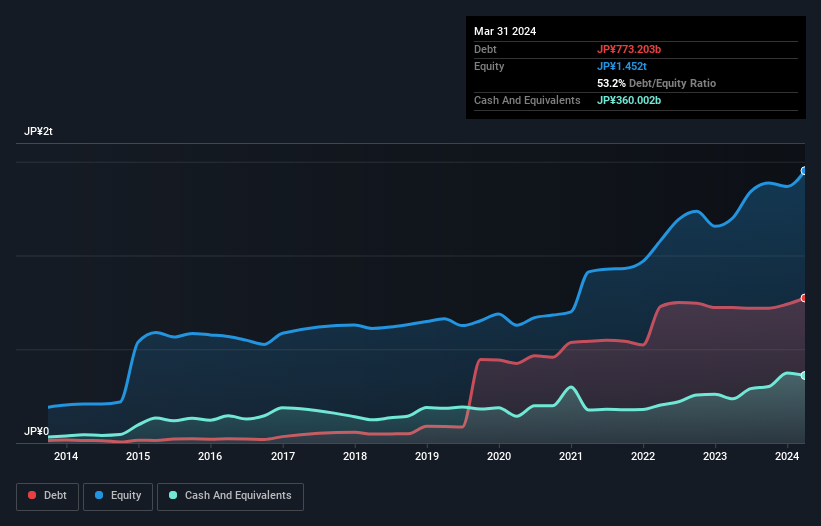Nippon Paint Holdings (TSE:4612) Seems To Use Debt Quite Sensibly

Warren Buffett famously said, 'Volatility is far from synonymous with risk.' When we think about how risky a company is, we always like to look at its use of debt, since debt overload can lead to ruin. Importantly, Nippon Paint Holdings Co., Ltd. (TSE:4612) does carry debt. But is this debt a concern to shareholders?
What Risk Does Debt Bring?
Debt assists a business until the business has trouble paying it off, either with new capital or with free cash flow. If things get really bad, the lenders can take control of the business. However, a more usual (but still expensive) situation is where a company must dilute shareholders at a cheap share price simply to get debt under control. Of course, debt can be an important tool in businesses, particularly capital heavy businesses. The first thing to do when considering how much debt a business uses is to look at its cash and debt together.
See our latest analysis for Nippon Paint Holdings
What Is Nippon Paint Holdings's Net Debt?
The image below, which you can click on for greater detail, shows that at March 2024 Nippon Paint Holdings had debt of JP¥773.2b, up from JP¥722.1b in one year. However, it does have JP¥360.0b in cash offsetting this, leading to net debt of about JP¥413.2b.

How Healthy Is Nippon Paint Holdings' Balance Sheet?
We can see from the most recent balance sheet that Nippon Paint Holdings had liabilities of JP¥578.6b falling due within a year, and liabilities of JP¥858.3b due beyond that. On the other hand, it had cash of JP¥360.0b and JP¥383.2b worth of receivables due within a year. So it has liabilities totalling JP¥693.6b more than its cash and near-term receivables, combined.
While this might seem like a lot, it is not so bad since Nippon Paint Holdings has a huge market capitalization of JP¥2.22t, and so it could probably strengthen its balance sheet by raising capital if it needed to. However, it is still worthwhile taking a close look at its ability to pay off debt.
We measure a company's debt load relative to its earnings power by looking at its net debt divided by its earnings before interest, tax, depreciation, and amortization (EBITDA) and by calculating how easily its earnings before interest and tax (EBIT) cover its interest expense (interest cover). This way, we consider both the absolute quantum of the debt, as well as the interest rates paid on it.
Nippon Paint Holdings's net debt to EBITDA ratio of about 1.8 suggests only moderate use of debt. And its commanding EBIT of 58.8 times its interest expense, implies the debt load is as light as a peacock feather. Importantly, Nippon Paint Holdings grew its EBIT by 42% over the last twelve months, and that growth will make it easier to handle its debt. The balance sheet is clearly the area to focus on when you are analysing debt. But ultimately the future profitability of the business will decide if Nippon Paint Holdings can strengthen its balance sheet over time. So if you want to see what the professionals think, you might find this free report on analyst profit forecasts to be interesting.
Finally, a business needs free cash flow to pay off debt; accounting profits just don't cut it. So the logical step is to look at the proportion of that EBIT that is matched by actual free cash flow. During the last three years, Nippon Paint Holdings produced sturdy free cash flow equating to 68% of its EBIT, about what we'd expect. This free cash flow puts the company in a good position to pay down debt, when appropriate.
Our View
Happily, Nippon Paint Holdings's impressive interest cover implies it has the upper hand on its debt. And that's just the beginning of the good news since its EBIT growth rate is also very heartening. Zooming out, Nippon Paint Holdings seems to use debt quite reasonably; and that gets the nod from us. After all, sensible leverage can boost returns on equity. Over time, share prices tend to follow earnings per share, so if you're interested in Nippon Paint Holdings, you may well want to click here to check an interactive graph of its earnings per share history.
When all is said and done, sometimes its easier to focus on companies that don't even need debt. Readers can access a list of growth stocks with zero net debt 100% free, right now.
Valuation is complex, but we're here to simplify it.
Discover if Nippon Paint Holdings might be undervalued or overvalued with our detailed analysis, featuring fair value estimates, potential risks, dividends, insider trades, and its financial condition.
Access Free AnalysisHave feedback on this article? Concerned about the content? Get in touch with us directly. Alternatively, email editorial-team (at) simplywallst.com.
This article by Simply Wall St is general in nature. We provide commentary based on historical data and analyst forecasts only using an unbiased methodology and our articles are not intended to be financial advice. It does not constitute a recommendation to buy or sell any stock, and does not take account of your objectives, or your financial situation. We aim to bring you long-term focused analysis driven by fundamental data. Note that our analysis may not factor in the latest price-sensitive company announcements or qualitative material. Simply Wall St has no position in any stocks mentioned.
Have feedback on this article? Concerned about the content? Get in touch with us directly. Alternatively, email editorial-team@simplywallst.com
About TSE:4612
Nippon Paint Holdings
Engages in the paints and fine chemicals businesses.
Moderate growth potential second-rate dividend payer.
Similar Companies
Market Insights
Community Narratives



